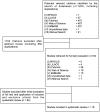Assessing the relationship between vector indices and dengue transmission: a systematic review of the evidence
- PMID: 24810901
- PMCID: PMC4014441
- DOI: 10.1371/journal.pntd.0002848
Assessing the relationship between vector indices and dengue transmission: a systematic review of the evidence
Abstract
Background: Despite doubts about methods used and the association between vector density and dengue transmission, routine sampling of mosquito vector populations is common in dengue-endemic countries worldwide. This study examined the evidence from published studies for the existence of any quantitative relationship between vector indices and dengue cases.
Methodology/principal findings: From a total of 1205 papers identified in database searches following Cochrane and PRISMA Group guidelines, 18 were included for review. Eligibility criteria included 3-month study duration and dengue case confirmation by WHO case definition and/or serology. A range of designs were seen, particularly in spatial sampling and analyses, and all but 3 were classed as weak study designs. Eleven of eighteen studies generated Stegomyia indices from combined larval and pupal data. Adult vector data were reported in only three studies. Of thirteen studies that investigated associations between vector indices and dengue cases, 4 reported positive correlations, 4 found no correlation and 5 reported ambiguous or inconclusive associations. Six out of 7 studies that measured Breteau Indices reported dengue transmission at levels below the currently accepted threshold of 5.
Conclusions/significance: There was little evidence of quantifiable associations between vector indices and dengue transmission that could reliably be used for outbreak prediction. This review highlighted the need for standardized sampling protocols that adequately consider dengue spatial heterogeneity. Recommendations for more appropriately designed studies include: standardized study design to elucidate the relationship between vector abundance and dengue transmission; adult mosquito sampling should be routine; single values of Breteau or other indices are not reliable universal dengue transmission thresholds; better knowledge of vector ecology is required.
Conflict of interest statement
The authors have declared that no competing interests exist.
Figures


References
-
- World Health Organization (2012) Global strategy for dengue prevention and control 2012–2020. World Health Organization. 43 pp. Available: http://apps.who.int/iris/bitstream/10665/75303/1/9789241504034_eng.pdf
Publication types
MeSH terms
Grants and funding
LinkOut - more resources
Full Text Sources
Other Literature Sources
Medical

